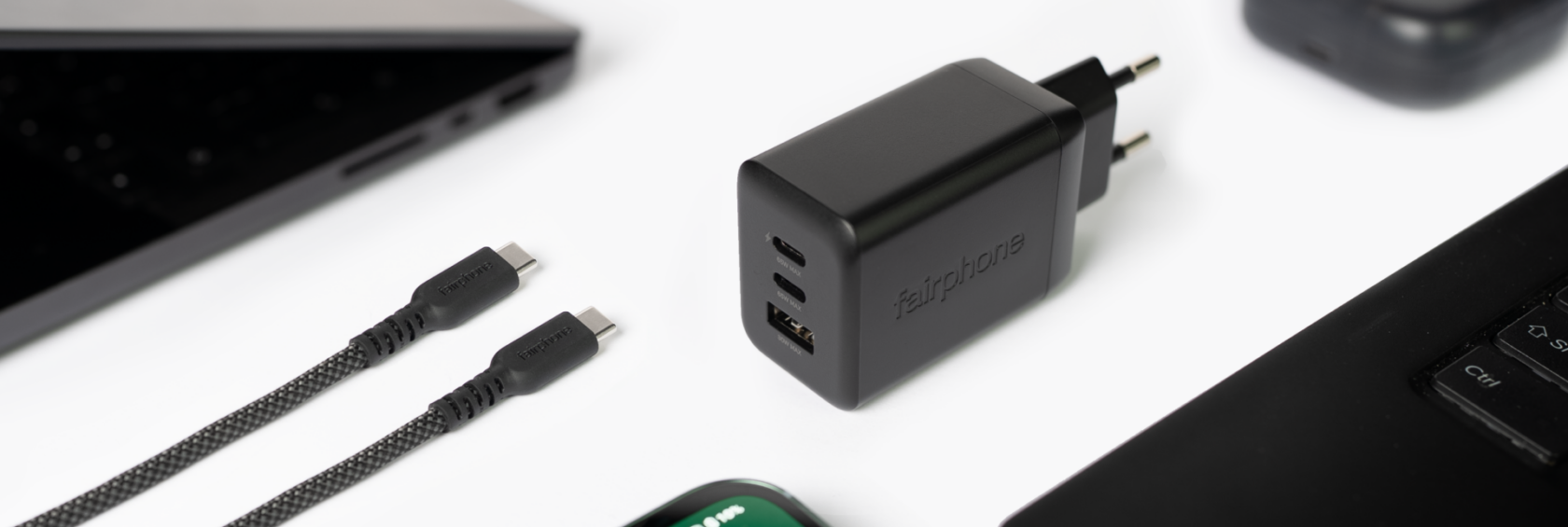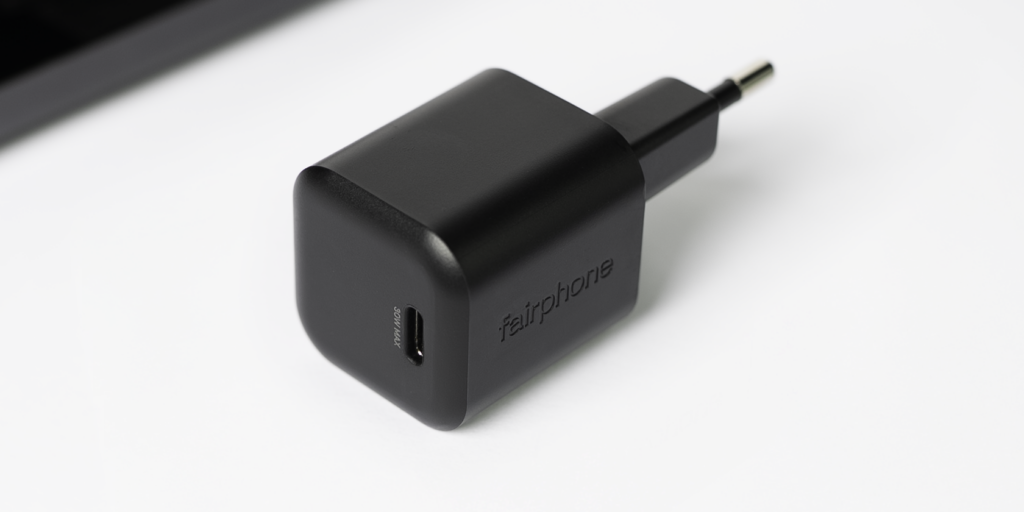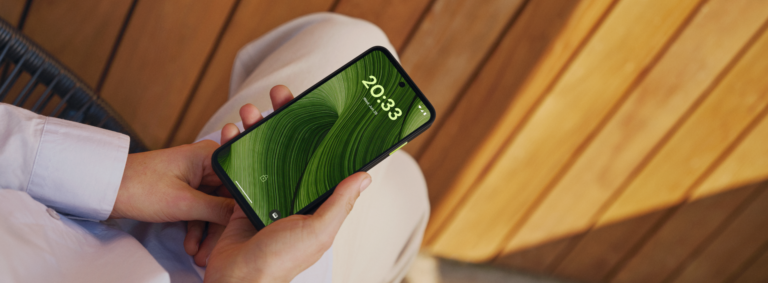Fairphone’s new cables and chargers are better in every way
Say hello to Fairphone’s all new line of USB long-life cables and fast chargers. With two models within each category, your charging experience has just become quicker, more powerful, and fairer than ever before. Here’s a quick overview.
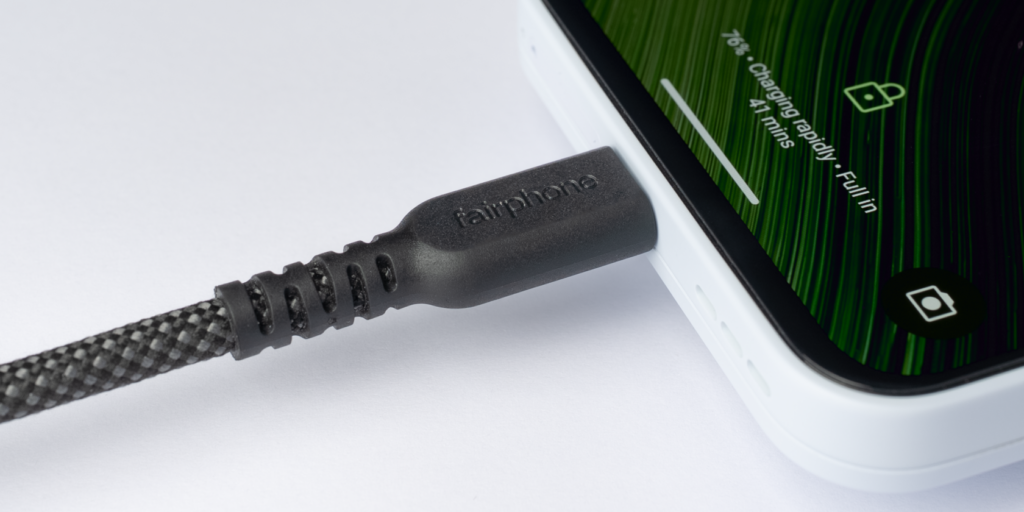
The Fairphone USB-C 3.2 Long Life Charging & Data Cable
USB-C 3.2 Long Life Charging & Data Cable
Charging outputs up to 240W. Transfer speeds up to a whopping 20Gbps. An integrated USB-A adapter. The USB-C 3.2 Long Life Charging & Data Cable works perfectly with almost any electronic device, and is easily our strongest cable as well, successfully clearing over 100,000 bend tests. With a three-year warranty, the LONGTIME® certified cable is also designed fair, with over 55% fair and recycled materials inside. It’s also made in fair factories, supports living wages for factory workers, and is assembled using 100% green energy. Oh, and it’s a 100% e-waste neutral too.
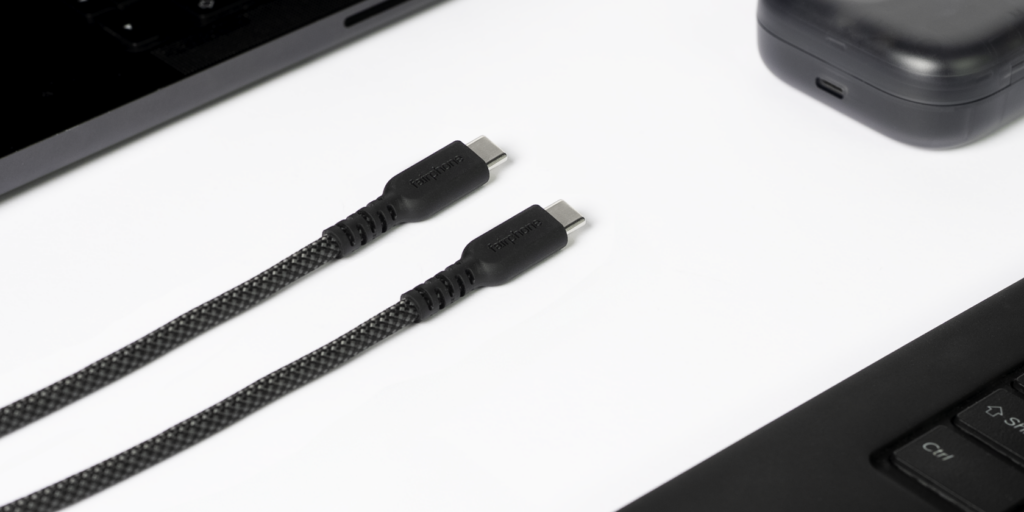
The Fairphone USB-C Long Life Charging Cable
USB-C Long Life Charging Cable
With an output of up to 240W, the Fairphone USB-C Long Life Charging Cable is your go-to when you want to power up your devices with little time to spare. Thanks to the integrated USB-A adapter, it is compatible with almost any electronic device with a USB port. It is also stronger than the competition, successfully clearing over 70,000 bend tests. With a three-year warranty, the LONGTIME® certified cable is also designed fair, with over 55% fair and recycled materials inside. It’s also made in fair factories, supports living wages for factory workers, and is assembled using 100% green energy. And just like its USB 3.2 cousin, it’s a 100% e-waste neutral too.
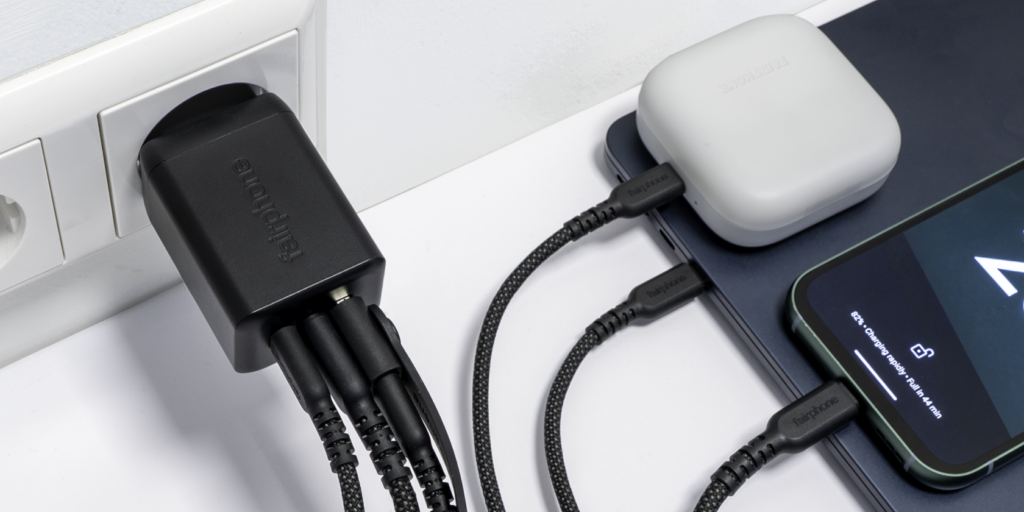
The Fairphone 65W Triple-Port Fast Charger
65W Triple-Port Fast Charger
Simultaneously charge up to three devices, including your laptop, using the two 65W USB-C ports plus one 30W USB-A port. Your devices stay protected as well, thanks to built-in short circuit protection and advanced temperature, current and voltage control. It’s LONGTIME® certified, and comes with a three-year extended warranty, so you know this charger is built to last. Our new 65W charger stays true to our sustainable design approach. It’s 100% e-waste neutral, and contains 98% recycled plastics, plus recycled copper-zinc alloy in the plug pins. It’s also made in fair factories, supports living wages for factory workers, and is assembled using 100% green energy.
30W USB-C Fast Charger
Charge faster and safer. Our new 30W GaN charger is small in size, but heavy on tech. It features advanced protection against short circuits and overheating. It’s compatible with all Fairphone (and non-Fairphone) devices and USB-C cables, and comes with a three-year extended warranty. And it fits in your pocket! It’s not just LONGTIME® certified, it’s made sustainably as well. The 100% e-waste neutral device contains 98% recycled plastics, and 100% recycled copper-zinc alloy in the plug pins. It’s also made in fair factories, supports living wages for factory workers, and is assembled using 100% green energy.
We sat down with Gregor Volk, our product manager in charge of all things accessories, to understand what makes our new line of cables and chargers fairer and better.
First off, why was the decision made to come up with a new line of cables and chargers?
What we had earlier was more than three years old. While they scored very well in durability and sustainability for their time, there were many aspects we saw we could improve. The USB 2.0 cable had cleared 10,000 bend tests, while the long-life cable was significantly better, clearing 25,000 bend tests. The charger used 40% recycled plastic in the housing. Similarly, with the USB2.0 cable, we had 100% recycled plastic in the braiding. These were things nobody else in the industry was doing at the time. But there was scope to do more. We wanted to engage with suppliers who meet our criteria for fair working conditions, see if they could implement living wage bonuses. We wanted to see how much more we could use fair and recycled materials in the products themselves. And right now, we felt, it was time. Not only could we refresh the fair specs of the products, enough time had passed for a proper tech update as well.
Going into the product design, what were some of the things that were priorities for you?
We approached the new cables and chargers like we approach our other devices, designing them from the ground up and exploring all possible ideas in a very elaborate concept phase. We were brainstorming in all directions. Initially, there was an idea to make the new cables and chargers repairable as well. However, we realized that we would have to use so much more material for the cables to make them modular and repairable. Not only did this outweigh sustainability benefits, we would have to give up on durability as well. With the chargers, modularity wasn’t even an option, as an open charger inherently has the risk of electrical shocks and fire hazards. Chargers are dangerous devices in that sense.
If not repairable, our focus then became on using as many fair and recycled materials as possible, reducing the overall materials used, and manufacturing them in good working conditions, while making the products as durable as possible.
They definitely sound sturdy and durable. The cables especially have some insane bend-test stats. The USB 2.0 cable’s cleared 70,000 bend tests, while the USB 3.0 cables survived a massive 100,000 tests! What’s that all about?
The benchmark for a very high-quality data or charging cable in the industry is 20,000 bend tests. That was what was accepted industry-wide until now. After our initial brainstorming, we had a clear concept in mind. These cables had to really, REALLY last. We had countless discussions with our engineering, quality, and impact team to see how far we could go. In the end, we set a crazy target for ourselves: 100,000 successful bend tests! Translated into user behavior, this means the cables survive for at least ten years. That’s a good enough window to account for changing technologies and new USB standards. What was interesting is that the footprint involved in going from 20,000 successful bend tests to 100,000 has been not that big.
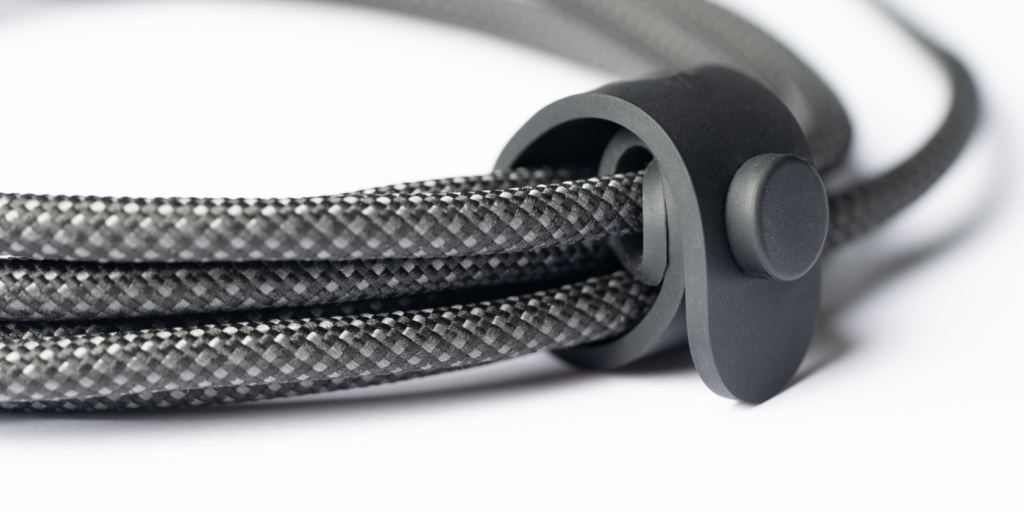
The new cables are strong and durable, clearing between 70,000 to 100,000 bend tests successfully.
So the cables are strong, they last really long, and they are also made with more fair and recycled materials than ever before?
Yes, the engineering and impact team did an amazing job here. Usually for the cables, the use of recycled materials impacts durability negatively. However, with some clever engineering, we were able to increase the durability of the cables, with while using fair and recycled materials that account for 55% to 70% of the product’s overall weight. Now put that in perspective. Our competitions can boast of maybe 40% recycled plastics in the braiding. The braiding only weighs four grams. That’s four grams out of a total weight of maybe 80 grams, or 2% of the overall weight. Think about it. 2% versus 55 to 70%! That’s crazy!
And then there’s the long-life promise. The bend tests are one thing, but if we are designing these cables to last ten years, then we have to make sure the tech doesn’t get out-of-date either. With charging cables, what’s important is the charging speed it can support, which is directly impacted by the power output. Usually, most smartphone chargers support 60W charging, with a few going beyond, with 100W charging, and even 240W charging. The more power output, the faster your device charges, provided it can support that wattage. Our new cables offer up to 240W of power, meaning you can charge power-hungry devices like laptops quickly and safely. Then there’s the transmission speed. With the USB3.2 cable, you get transfer speeds of up to 20Gbps. Both cables support all possible charging protocols as well, from Apple to Samsung and more.
So it’s future-proof, but it’s also retro-proofed in a way with the integrated USB-A adapter.
Yes, the USB-A adapter is something that has really grown on me. It makes the cable compatible with your older devices and older ports as well, especially on airplanes and in cars and so on. This time around, it’s detachable as well, making it more modular.
Let’s talk about chargers. What was the team’s thought process when it came to designing them?
Chargers are relatively a more difficult product category, given the risks involved. We chose a reputed supplier who is known for making extremely-good chargers. Energy efficient, compact form factor. Our new 65W charger is as big as our old 30W charger, while the new 30W charger is so small, it will fit in any pocket. This also makes it more sustainable, as a smaller form factor means lower material use. Then there’s the versatility angle we thought about. The idea behind the triple-port charger was to create one charger to charge all your devices at the same time, while still being easy to carry around. With this charger, you can charge your headphones, your phone and your laptop simultaneously. While we hope more and more manufacturers stop including unnecessary chargers in their packaging, we wanted to offer a sustainable solution that works better than the competition for people who still might need one.
So how did you go about making these chargers more sustainable?
We managed to do that by working with our suppliers closely. We worked with them to use 98% recycled plastic in the casing, and were also able to integrate recycled copper-zinc alloy in the plug pins, which is a big part of the charger. Their factories were audited by us, to make sure working conditions met our standards. Factory workers who worked on both chargers and cables were paid a living wage bonus. Then, there are things we have done at our end. For example, we invest in Fairtrade Gold credits to compensate for the gold we used in all our products. We have also ensured that these new cables and chargers are 100% e-waste neutral, by recycling an equivalent weight of electronic waste for every one of these products that we make.
And they work across devices and brands?
What’s important to understand is that charging has gotten a lot more complex than ten years ago. There is now a tiny computer chip on every modern charger that, before charging, aligns with the connected device to see which charging protocols are supported by both. Afterward, both negotiate on which charging protocol to use, keeping in mind safety and efficiency. That’s why it is not just about how much power a charger can output. The number of charging protocols supported is equally important.
For example, if you use an Apple charger to charge a Fairphone device, it is not going to charge it optimally, because the best charging protocol for our phones is missing on Apple. As a result, their 100W charger won’t be as effective as our 30W charger. Our chargers, on the other hand, are designed to support every common charging protocol, making sure (almost) all devices you use with our chargers charge optimally. You don’t need to lug around different chargers anymore. Our Fairphone charger will charge your MacBook the same way the Apple charger will charge your MacBook.
As someone who has been working with chargers so closely for the past year or so, what are some of the things you look out for when buying a charger?
I think the most important factors are quality and safety. Some of the chargers you see online are available at a cost price of just two euros. But when you open them up, you can see how badly they have been assembled, how substandard the quality is. You might get electrocuted using it, or it might even catch fire. That’s why I would rather invest in a good charger from a brand that I trust, over using a free charger I get when buying second-hand or refurbished electronics. Quality is so, so important. It’s directly linked to safety. Our chargers have good build quality and have been tested on numerous reliability tests. In addition, they have multiple safety features like temperature control, protection against short circuits, and a safety shut-off mechanism if the device suddenly draws an alarmingly high current, or if the input voltage changes rapidly.
Any closing remarks?
Both the chargers and the cables are excellent examples of what is possible when you redesign basic technology to work better, to last longer, and to be made fairer. All the credit should go to Fairphone’s engineering and impact teams.
Fairphone’s new line of cables and chargers are now available on Fairphone’s webshop.
